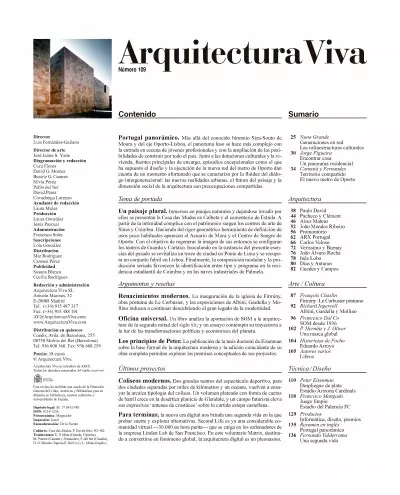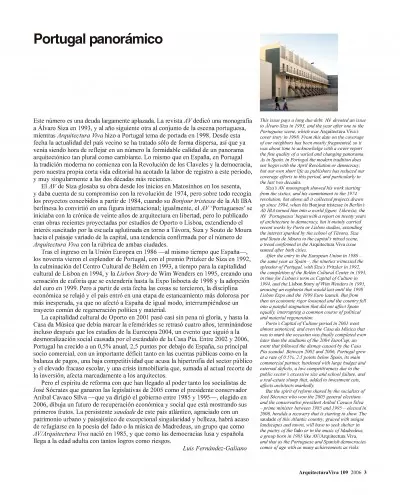Synopses
Panoramic Portugal. Beyond the well-known duo Siza-Souto de Moura and the Porto-Lisbon axis, Portugal’s panorama is becoming more complex with the coming on stage of young professionals and with the growing opportunities to build in the different regions of the country. Together with cultural buildings and housing, which are currently the main sources of commissions, exceptional projects such as the development of the new network for the Porto metro testify to a fortunate moment characterized by a very fluent dialogue among generations: the new urban realities, the future of landscape and the social dimension of architecture are concerns shared by all.
Contents
Nuno Grande
Connected Generations
The Cultural Infrastructures
Jorge Figueira
Finding a House
A Residential Panorama
Cannatà & Fernandes
Shared Territory
The New Metro of Porto
Cover Story
A Plural Landscape.The Casa das Mudas in Calheta and the Cemetery of Estrela merge gently into and are invaded by their natural environments. The art centers of Sines and Coimbra emerge from a close connection with
heritage. The aquarium of Mora and the blood bank of Porto turn geometric rigor into a tool used to define very specific programs. The theaters of Guarda and Cartaxo go up with the purpose of regenerating the image of their surroundings. The revitalization of a section of the city of Ponte de Lima and the refurbishment of an industrial complex in Lisbon impregnate the substance of the present with essences of the past. Finally, modular composition and serial production favor the identification between type and program both in the student hall of Coimbra and in the industrial sheds of Palmela.
Architecture
Paulo David
Pacheco & Clément
Aires Mateus
João Mendes Ribeiro
Promontório
ARX Portugal
Carlos Veloso
Veríssimo & Burnay
João Álvaro Rocha
Inês Lobo
Dias & Antunes
Guedes & Campos
Views and Reviews
Modern Renaissance. The completion of the church of Firminy, a posthumous work by Le Corbusier, and the exhibitions of Albini, Gardella and Mollino encourage to rediscover the great legacy of modernity.
Art / Culture
François Chaslin
Firminy: Le Corbusier at Last
Richard Ingersoll
Albini, Gardella & Mollino
Universal Office. A recent book analyzes the contribution of SOM to the architecture of the second half of the 20th century; and an article reviews its trajectory in the light of political and economic globalization.Francesco Dal Co
SOM since 1936
P. Hernáiz & J. Oliver
A Global BrandThe Peter Principles.The publication of Eisenman’s thesis on the formal basis of modern architecture and the release at the same time of a volume with his complete works prompt to explore the conceptual premises of his projects.Focho’s Cartoon
Eduardo Arroyo
Various Authors
Books
Recent Projects
Modern Coliseums. Two large theaters for the spectacle of sports, in two cities separated by thousands of kilometers and an ocean, reinterpret the archaic typology of the coliseum. A silver barrel cactus-shaped volume grows in the desert plains of Glendale, and a futuristic soccer field lifts its expressive ‘crustacean antennae’ over the weathered Castilian steppe.
Technique / Style
Peter Eisenman
Silver Display
Arizona Cardinals Stadium
Francisco Mangado
Fair Play
Palencia Soccer Stadium
To close, the new digital era offers a second existence in which to try one’s luck and explore alternatives. Second Life is already a considerable virtual community – 30,000 users at peak time – that is developed in the computers of the San Francisco company Linden Lab. In this voluntary Matrix, destined to become a global phenomenon, digital architecture is a pleonasm.Products
Computers, Design, Awards
English Summary
Panoramic Portugal
Fernando Valderrama
A Second Life
Luis Fernández-Galiano
Panoramic Portugal
This issue pays a long due debt. AV devoted an issue to Álvaro Siza in 1993, and the year after one to the Portuguese scene, which was Arquitectura Viva’s cover story in 1998. From this date on the coverage of our neighbors has been mostly fragmented, so it was about time to acknowledge with a cover report the fine quality of a varied and changing panorama. As in Spain, in Portugal the modern tradition does not begin with the April Revolution or democracy, but our own short life as publishers has reduced our coverage efforts to this period, and particularly to the last two decades.
Siza’s AV monograph showed his work starting from the sixties, and his commitment to the 1974 revolution, but above all it collected projects drawn up since 1984, when his Bonjour tristesse in Berlin’s Alt IBA turned him into a world figure. Likewise, the AV ‘Portugueses’ began with a report on twenty years of architecture in democracy, but it mainly carried recent works by Porto or Lisbon studios, extending the interest sparked by the school of Távora, Siza and Souto de Moura to the capital’s mixed scene, a trend confirmed in the Arquitectura Viva issue named after both cities.
After the entry in the European Union in 1986 – the same year as Spain –, the nineties witnessed the splendor of Portugal, with Siza’s Pritzker in 1992, the completion of the Belém Cultural Center in 1993, in time for Lisbon’s term as Capital of Culture in 1994, and the Lisbon Story of Wim Wenders in 1995, arousing an euphoria that would last until the 1998 Lisbon Expo and the 1999 Euro launch. But from then on economic rigor loosened and the country fell into a painful stagnation that did not affect Spain equally, interrupting a common course of political and material regeneration.
Porto’s Capital of Culture period in 2001 went almost unnoticed, and even the Casa da Música that was to mark the occasion was finally completed even later than the stadiums of the 2004 EuroCup, an event that followed the dismay caused by the Casa Pia scandal. Between 2002 and 2006, Portugal grew at a rate of 0.5%, 2.5 points below Spain, its main commercial partner, burdened with large budget and external deficits, a low competitiveness due to the public sector’s excessive size and school failure, and a real-estate slump that, added to investment cuts, affects architects markedly.
But the spirit of reform shared by the socialists of José Sócrates who won the 2005 general elections and the conservative president Aníbal Cavaco Silva – prime minister between 1985 and 1995 – elected in 2006, heralds a recovery that is starting to show. The saudade of this Atlantic country, graced with unique landscapes and towns, will have to seek shelter in the poetry of the fado or in the music of Madredeus, a group born in 1985 like AV/Arquitectura Viva, and that as the Portuguese and Spanish democracies comes of age with as many achievements as risks.








